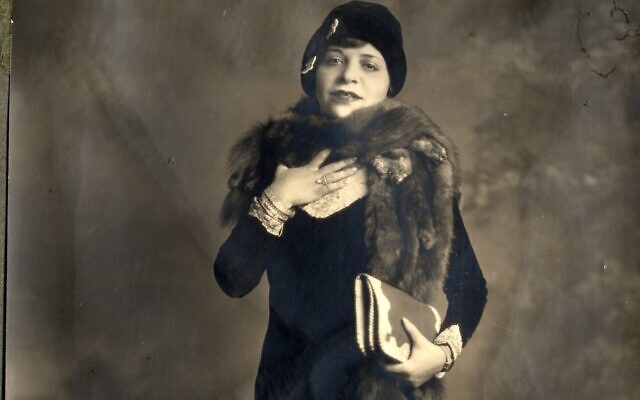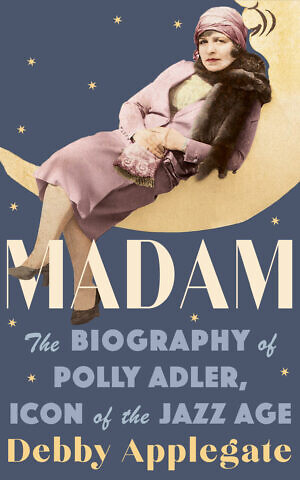What’s Jewish About…The Jazz Age?
In this month’s column, Pulitzer Prize-winning, historian author Debby Applegate shares a fascinating perspective on Polly Adler in her book, “Madam: The Biography of Polly Adler, Icon of the Jazz Age.”
Robyn Spizman Gerson is a New York Times best-selling author of many books, including “When Words Matter Most.” She is also a communications professional and well-known media personality, having appeared often locally on “Atlanta and Company” and nationally on NBC’s “Today” show. For more information go to www.robynspizman.com.

In this month’s column, Pulitzer Prize-winning, historian author Debby Applegate shares a fascinating perspective on Polly Adler in her book, “Madam: The Biography of Polly Adler, Icon of the Jazz Age.”
Tell us about the iconic Polly Adler.
Adler was an internationally notorious madam in Jazz Age Manhattan, whose opulent brothels served as secret salons where celebrities, politicians, gangsters, businessmen, athletes and entertainers mingled. Newspapers dubbed her “the female Al Capone” but she called herself an unorthodox Horatio Alger hero. “A cynical person might say my life had been a typical American success story,” Adler said. “From a nobody to a legend.”
How did her Jewish upbringing shape her?
Adler was born in 1900 in a small town, a “shtetl” in Yiddish, in the Russian Pale, now Belarus. Unlike most girls of the era, her parents encouraged her passion for education. She was studying with the local rabbi to go to school in the city of Pinsk, when pogroms began sweeping through Russia and her father decided to move the family to America. Adler went first, landing alone on Ellis Island in December 1913.
What happened when she got to America?
Before her family could join her, World War I began, leaving 14-year-old Adler stranded among strangers. She quit school to take a job in a garment factory in Brooklyn, but trouble followed. She was date-raped by her boss, became pregnant, had an illegal abortion and was thrown out of her home. Desperate, she turned to the sex trade to survive, as she said, “until I had saved enough money to quit and find myself a decent man.”

How was her fate shaped by the Roaring Twenties?
Adler opened her first brothel in 1920, the same year that Prohibition began, criminalizing the sale of liquor in the U.S. Ironically, banning booze glamorized the underworld of vice, to Polly’s benefit. “I was a creation of the times, of an era whose credo was: ‘Anything which is economically right is morally right,’” she remembered. “In fact, if I had all of history to choose from, I could hardly have picked a better age in which to be a madam.”
What happened when she turned her ambition to crime?
“If I had to be a madam,” Adler declared, “I was determined to be the best goddam madam in all America.” She hit the jackpot when she befriended Arnold Rothstein, czar of the Jewish underworld, and big-time bootleggers Meyer Lansky, Bugsy Siegel and Dutch Schultz. In the Jewish tradition of the balabusta, she combined warm hospitality with hard-headed business sense. Soon enough, she was entertaining the luminaries of Wall Street, Madison Avenue, Broadway, Hollywood and Washington, D.C.
Did she ever get caught?
By the 1930s, Adler’s notoriety attracted the attention of FBI director J. Edgar Hoover and gangbuster Thomas E. Dewey. She went on the lam to Miami, Havana and Los Angeles. But in 1935, the NYPD finally sent her to jail for 30 days. Ironically, the newspaper publicity only burnished her reputation. Her brothel became the chic, after-hours hideaway for the sophisticates of Café Society and in 1939 she was proudly featured in Fortune magazine. Adler thrived through World War II, catering to military men and visiting dignitaries.
How did her career end?
After 25 years as the “Queen of Tarts,” Adler had achieved her version of the American Dream, but she still craved mainstream respect. So, in 1945, she retired to Los Angeles and went back to school, earning a high school diploma and an associate degree at L.A. City College. In 1953, Adler published “A House is Not a Home,” a memoir of her criminal career. It was a smash hit, selling two million copies in a dozen languages, catapulting her to literary celebrity. The film rights were sold to Hollywood with Joan Crawford, Barbara Stanwyck, Ethel Merman and Martha Raye competing to play “the Jewish Jezebel.” The 1964 film starring Shelley Winters bombed, but the costume designer Edith Head was nominated for an Academy Award, the title song by Burt Bacharach became a hit and Raquel Welch made her film debut as one of Adler’s girls.
How is Adler remembered?
When Adler died in 1963, she was a bona fide legend. Long, respectful obituaries ran in newspapers across the country. “The old cat died a literary lion,” proclaimed Time magazine. But above all, she was a survivor. As she once quipped, “I can only say that I am one of those people who just can’t help getting a kick out of life—even when it’s a kick in the teeth.”
“Madam: The Biography of Polly Adler, Icon of the Jazz Age” (Doubleday) by Debby Applegate is for sale wherever books are sold. Visit www.debby-applegate.com.
- What's Jewish About
- Opinion
- Robyn Spizman Gerson
- Debby Applegate
- Madam: The Biography of Polly Adler
- Icon of the Jazz Age
- Jazz Age Manhattan
- the female Al Capone
- Horatio Alger
- Shtetl
- Russian Pale
- Belarus
- Pinsk
- Ellis Island
- World War I
- Prohibition
- Arnold Rothstein
- Meyer Lansky
- Bugsy Siegel
- Dutch Schultz
- Wall Street
- Madison Avenue
- broadway
- Hollywood
- Washington
- Washington D.C.
- FBI director J. Edgar Hoover
- Thomas E. Dewey
- NYPD
- Café Society
- Fortune magazine
- World War II
- Queen of Tarts
- L.A. City College
- A House is Not a Home
- Joan Crawford
- Barbara Stanwyck
- Ethel Merman
- Martha Raye c
- the Jewish Jezebel
- Shelley Winters
- costume designer Edith Head
- Academy Award
- Burt Bacharach
- Raquel Welch
- TIME magazine



comments